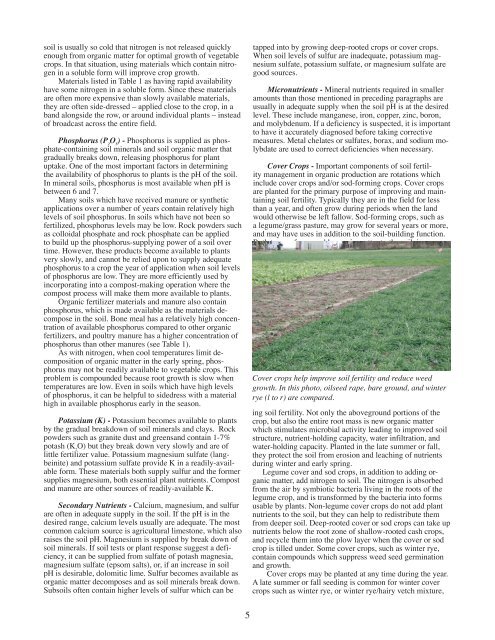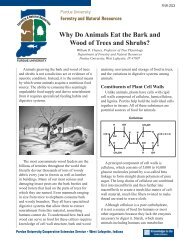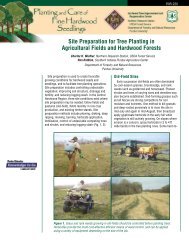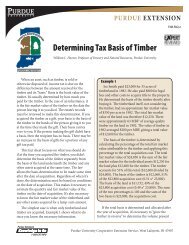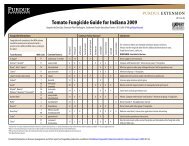Organic Vegetable Production - Purdue Extension - Purdue University
Organic Vegetable Production - Purdue Extension - Purdue University
Organic Vegetable Production - Purdue Extension - Purdue University
You also want an ePaper? Increase the reach of your titles
YUMPU automatically turns print PDFs into web optimized ePapers that Google loves.
soil is usually so cold that nitrogen is not released quickly<br />
enough from organic matter for optimal growth of vegetable<br />
crops. In that situation, using materials which contain nitrogen<br />
in a soluble form will improve crop growth.<br />
Materials listed in Table 1 as having rapid availability<br />
have some nitrogen in a soluble form. Since these materials<br />
are often more expensive than slowly available materials,<br />
they are often side-dressed – applied close to the crop, in a<br />
band alongside the row, or around individual plants – instead<br />
of broadcast across the entire field.<br />
Phosphorus (P 2 O 5 ) - Phosphorus is supplied as phosphate-containing<br />
soil minerals and soil organic matter that<br />
gradually breaks down, releasing phosphorus for plant<br />
uptake. One of the most important factors in determining<br />
the availability of phosphorus to plants is the pH of the soil.<br />
In mineral soils, phosphorus is most available when pH is<br />
between 6 and 7.<br />
Many soils which have received manure or synthetic<br />
applications over a number of years contain relatively high<br />
levels of soil phosphorus. In soils which have not been so<br />
fertilized, phosphorus levels may be low. Rock powders such<br />
as colloidal phosphate and rock phosphate can be applied<br />
to build up the phosphorus-supplying power of a soil over<br />
time. However, these products become available to plants<br />
very slowly, and cannot be relied upon to supply adequate<br />
phosphorus to a crop the year of application when soil levels<br />
of phosphorus are low. They are more efficiently used by<br />
incorporating into a compost-making operation where the<br />
compost process will make them more available to plants.<br />
<strong>Organic</strong> fertilizer materials and manure also contain<br />
phosphorus, which is made available as the materials decompose<br />
in the soil. Bone meal has a relatively high concentration<br />
of available phosphorus compared to other organic<br />
fertilizers, and poultry manure has a higher concentration of<br />
phosphorus than other manures (see Table 1).<br />
As with nitrogen, when cool temperatures limit decomposition<br />
of organic matter in the early spring, phosphorus<br />
may not be readily available to vegetable crops. This<br />
problem is compounded because root growth is slow when<br />
temperatures are low. Even in soils which have high levels<br />
of phosphorus, it can be helpful to sidedress with a material<br />
high in available phosphorus early in the season.<br />
Potassium (K) - Potassium becomes available to plants<br />
by the gradual breakdown of soil minerals and clays. Rock<br />
powders such as granite dust and greensand contain 1-7%<br />
potash (K 2 O) but they break down very slowly and are of<br />
little fertilizer value. Potassium magnesium sulfate (langbeinite)<br />
and potassium sulfate provide K in a readily-available<br />
form. These materials both supply sulfur and the former<br />
supplies magnesium, both essential plant nutrients. Compost<br />
and manure are other sources of readily-available K.<br />
Secondary Nutrients - Calcium, magnesium, and sulfur<br />
are often in adequate supply in the soil. If the pH is in the<br />
desired range, calcium levels usually are adequate. The most<br />
common calcium source is agricultural limestone, which also<br />
raises the soil pH. Magnesium is supplied by break down of<br />
soil minerals. If soil tests or plant response suggest a deficiency,<br />
it can be supplied from sulfate of potash magnesia,<br />
magnesium sulfate (epsom salts), or, if an increase in soil<br />
pH is desirable, dolomitic lime. Sulfur becomes available as<br />
organic matter decomposes and as soil minerals break down.<br />
Subsoils often contain higher levels of sulfur which can be<br />
5<br />
tapped into by growing deep-rooted crops or cover crops.<br />
When soil levels of sulfur are inadequate, potassium magnesium<br />
sulfate, potassium sulfate, or magnesium sulfate are<br />
good sources.<br />
Micronutrients - Mineral nutrients required in smaller<br />
amounts than those mentioned in preceding paragraphs are<br />
usually in adequate supply when the soil pH is at the desired<br />
level. These include manganese, iron, copper, zinc, boron,<br />
and molybdenum. If a deficiency is suspected, it is important<br />
to have it accurately diagnosed before taking corrective<br />
measures. Metal chelates or sulfates, borax, and sodium molybdate<br />
are used to correct deficiencies when necessary.<br />
Cover Crops - Important components of soil fertility<br />
management in organic production are rotations which<br />
include cover crops and/or sod-forming crops. Cover crops<br />
are planted for the primary purpose of improving and maintaining<br />
soil fertility. Typically they are in the field for less<br />
than a year, and often grow during periods when the land<br />
would otherwise be left fallow. Sod-forming crops, such as<br />
a legume/grass pasture, may grow for several years or more,<br />
and may have uses in addition to the soil-building function.<br />
Both types of crops add organic matter to the soil, improv-<br />
Cover crops help improve soil fertility and reduce weed<br />
growth. In this photo, oilseed rape, bare ground, and winter<br />
rye (l to r) are compared.<br />
ing soil fertility. Not only the aboveground portions of the<br />
crop, but also the entire root mass is new organic matter<br />
which stimulates microbial activity leading to improved soil<br />
structure, nutrient-holding capacity, water infiltration, and<br />
water-holding capacity. Planted in the late summer or fall,<br />
they protect the soil from erosion and leaching of nutrients<br />
during winter and early spring.<br />
Legume cover and sod crops, in addition to adding organic<br />
matter, add nitrogen to soil. The nitrogen is absorbed<br />
from the air by symbiotic bacteria living in the roots of the<br />
legume crop, and is transformed by the bacteria into forms<br />
usable by plants. Non-legume cover crops do not add plant<br />
nutrients to the soil, but they can help to redistribute them<br />
from deeper soil. Deep-rooted cover or sod crops can take up<br />
nutrients below the root zone of shallow-rooted cash crops,<br />
and recycle them into the plow layer when the cover or sod<br />
crop is tilled under. Some cover crops, such as winter rye,<br />
contain compounds which suppress weed seed germination<br />
and growth.<br />
Cover crops may be planted at any time during the year.<br />
A late summer or fall seeding is common for winter cover<br />
crops such as winter rye, or winter rye/hairy vetch mixture,


